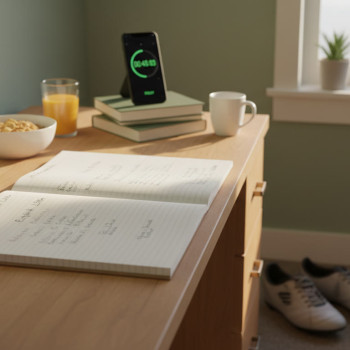Why units matter (and why every AP point starts here)
If you’ve ever lost easy points on an AP Physics free-response question because your answer was 9.8 instead of 9.8 m/s², you already know the gravity of units. Units are the language of physics. They tell the reader what the number means, anchor your algebra to reality, and — when used correctly — can rescue you even when algebra starts to wobble.
In this guide I’ll walk you through the SI base units, the most useful derived units you’ll see on AP exams, quick conversion strategies, and simple mental checks that make unit errors rare. You’ll also find worked examples, a handy conversion table, and study approaches that fit into a busy AP schedule. If you ever want individualized help, Sparkl’s personalized tutoring (1-on-1 guidance, tailored study plans, expert tutors, and AI-driven insights) is a great way to get targeted feedback on unit problems and test practice.
Quick refresher: Base units you must know cold
The International System of Units (SI) gives us a compact set of base quantities that can describe every physical measurement. For AP Physics, memorize these and their symbols. They’re your building blocks.
- Length — meter (m)
- Mass — kilogram (kg)
- Time — second (s)
- Electric current — ampere (A)
- Thermodynamic temperature — kelvin (K)
- Amount of substance — mole (mol)
- Luminous intensity — candela (cd) (rare on AP exams, but worth recognizing)
These seven are the atomic vocabulary of measurements. Everything else is constructed from them.
Photo Idea : A clean, overhead photo of a student’s AP Physics notebook open on a desk with a ruler, stopwatch, and calculator — labeled items pointing to meter, second, kilogram. This image introduces the base units visually and places the reader in study mode.
Derived units: built from the base blocks
Derived units are combinations of base units and they appear constantly on AP problems. Recognizing them quickly helps you set up equations correctly and perform unit checks during multi-step calculations.
- Velocity — meters per second (m/s) — length over time.
- Acceleration — meters per second squared (m/s²) — velocity change over time.
- Force — newton (N) = kg·m/s² — mass times acceleration; Newton’s second law lives here.
- Energy/Work — joule (J) = N·m = kg·m²/s² — a commonly tested quantity in work-energy problems.
- Power — watt (W) = J/s = kg·m²/s³ — rate of doing work or transferring energy.
- Pressure — pascal (Pa) = N/m² = kg/(m·s²) — important for fluids and thermodynamics.
- Electric charge — coulomb (C) = A·s
- Voltage — volt (V) = J/C = kg·m²/(A·s³)
When you see a derived unit, mentally unpack its base units. Working backward like this is a reliable way to sanity-check formulas and units in free-response steps.
Common conversion situations on AP exams
AP problems often require converting between metric prefixes, between units (e.g., km to m), or between different systems (rarely between SI and imperial but sometimes). Here are the situations you’ll encounter most:
- Metric prefix conversions (e.g., km ↔ m, cm ↔ m, ms ↔ s)
- Energy and power units (J, kJ, cal, eV occasionally in conceptual context)
- Pressure units (kPa is common; Pa appears in equations)
- Using constants given in problem statements (don’t convert unless asked)
Simple rules that save time
- Convert values to base SI units early (meters, kilograms, seconds). Solving in base units keeps your algebra straightforward.
- Track units algebraically like variables — cancel units with division and multiply them for multiplication steps.
- When using given constants (g = 9.8 m/s²), keep units consistent. If height is in centimeters, convert to meters first.
- For metric prefixes, remember this string: kilo (k, 10^3), centi (c, 10^-2), milli (m, 10^-3), micro (μ, 10^-6). For quick mental math, move the decimal point instead of re-deriving powers of ten.
Fast conversion cheat sheet (table)
Use this table for the conversions you’ll most often need while practicing or during the exam.
| Quantity | Common Units | Relationship | Quick Tip |
|---|---|---|---|
| Length | km, m, cm, mm | 1 km = 1000 m; 1 m = 100 cm; 1 cm = 10 mm | Shift decimal 3 left for km→m |
| Mass | kg, g | 1 kg = 1000 g | Convert grams to kg by dividing by 1000 |
| Time | s, ms, min | 1 min = 60 s; 1 s = 1000 ms | Watch mixing minutes with seconds |
| Force | N | 1 N = 1 kg·m/s² | Derive units when checking Newton’s 2nd law |
| Energy | J, kJ | 1 kJ = 1000 J | Work in J; convert only at the end |
| Pressure | Pa, kPa | 1 kPa = 1000 Pa | Fluids often use kPa or kN/m² |
Worked examples: unit-savvy problem solving
Let’s walk through two typical AP-style problems and show how units guide the solution.
Example 1 — From speed to kinetic energy
Problem: A 2.0 kg cart travels at 3.0 m/s. What is its kinetic energy in joules?
Step 1: Write the formula and plug units: KE = 1/2 m v² → units = kg·(m/s)² = kg·m²/s² → which is a joule (J).
Step 2: Compute numerically: KE = 0.5 × 2.0 kg × (3.0 m/s)² = 1 × 9 = 9.0 J.
Unit check: kg·m²/s² → J. Done. If you had a velocity in cm/s, convert to m/s before squaring.
Example 2 — Pressure and area
Problem: A force of 200 N is applied uniformly over a 0.5 m² area. What is the pressure in pascals?
Solution: Pressure = Force / Area = 200 N / 0.5 m² = 400 N/m² = 400 Pa.
Unit check: N/m² is the definition of Pa, so the numerical answer stands. If the area had been given in cm², convert to m² first (1 cm² = 1e-4 m²).
Unit-trouble hotspots and how to fix them
Certain steps repeatedly trip up students. Recognizing them ahead of time saves time and points.
- Squaring or cubing numbers with prefixes: When squaring 50 cm, remember (0.50 m)² = 0.25 m², not 2500. Convert first, then apply exponents.
- Forgetting that pounds are a force: If a problem gives mass as “70 kg” and weight in newtons, keep mass in kg when using F=ma. If weight is given in pounds (lb), convert to newtons or to mass in slugs only if necessary.
- Mixing minutes and seconds: Put everything into seconds for dynamics or frequency problems.
- Electrical units: For circuits, track A and s for charge (C = A·s) and keep energy in J when using V = J/C.
Quick mental checks (the kind that win points)
Before scribbling the final answer on the FRQ sheet, run these quick checks:
- Does the unit match the requested quantity? (e.g., answer asked in N but you have kg·m/s² — they match.)
- Dimensional plausibility: Does a speed of 300 m/s for a bicycle make sense? If not, check conversions.
- Cancel units across numerator and denominator — if units don’t cancel to the expected final unit, you missed a conversion.
- For multi-step problems, place units at every step. If units change unexpectedly, backtrack immediately.
Study habits to make units instinctive
Turning units from a chore into second nature takes practice and patterns, not endless memorization. Try these practical study habits:
- Write units in every line: When solving practice problems, include units in intermediate steps. The extra ink is faster than lost points.
- Flashcard the prefixes: A deck with 10–15 prefix cards gets you 90% of conversion needs.
- Drill dimensional analysis: Make up a weekly 10-minute exercise where you state the base units for common derived units (e.g., V, J, W, Pa) until it’s reflexive.
- Timed practice under exam conditions: Work a section of AP-style problems focusing only on units and conversions to build confidence and speed.
- Use targeted tutoring: If you find recurring unit mistakes, consider a few 1-on-1 sessions. Personalized tutoring (like Sparkl’s tailored plans and expert tutors) can debug patterns in your work and give focused practice where you need it most.
How to convert quickly without a calculator (for rough checks)
You won’t always want to reach for a calculator. Some quick arithmetic tricks let you estimate and sanity check answers:
- Move the decimal for metric prefixes: multiply/divide by powers of ten instead of recalculating exponents.
- Use simple fractions for common conversions: 1 km ≈ 0.62 miles (handy for intuitive checks); 1 inch ≈ 2.54 cm.
- Round constants for rough work: Use g ≈ 9.8 m/s² or 10 m/s² when estimating, but use 9.8 on the actual AP exam unless instructed otherwise.
- When squaring a number with a decimal, consider converting to an integer first (e.g., 0.03 m = 3 × 10^-2 m; squaring gives 9 × 10^-4 m²) — this helps avoid misplacing decimal places.
How units appear on the AP exam and how graders read them
AP graders look for correct reasoning and clear presentation. Units are part of both. Here’s what they reward:
- Consistent use of SI units across the solution.
- Showing unit algebra in intermediate steps where unit cancellation is not obvious.
- Correct conversions when the problem gives non-SI numbers (e.g., masses in grams or areas in cm²).
- A final numerical answer with the correct unit attached and the appropriate number of significant figures when requested.
Even a correct numeric answer can cost points if the unit is wrong or missing. Don’t let a missing “m” or “s” cost you.
Final checklist for exam day
On test day, keep this one-page checklist in mind as a mental routine after finishing each calculation:
- Are all values in SI base units? (If not, convert now.)
- Does the final unit match the quantity asked for?
- Did you square or cube converted numbers correctly?
- Are significant figures reasonable and consistent with the question’s data?
- If you used a constant from the prompt, did you keep its units attached through the calculation?
Putting it all together — a study plan for one week
If you’ve got one week before a unit test or exam section on units, here’s a compact routine you can follow. It’s designed for busy AP students who want maximum impact with focused effort.
- Day 1 — Base review: Memorize the seven SI base units. Make flashcards for metric prefixes.
- Day 2 — Derived units: Write out the base-unit decomposition of 8–10 derived units (N, J, W, Pa, V, C, T).
- Day 3 — Conversions practice: Do 20 conversion problems (metric prefixes, area/volume conversions, time unit changes).
- Day 4 — Dimensional analysis drills: Practice identifying wrong formulas by checking units only (no numbers).
- Day 5 — Mixed problems: Complete a timed AP-style set with a focus on unit handling.
- Day 6 — Peer review or tutor check: Have a study partner or a tutor review your work. Personalized feedback from a tutor (for example Sparkl’s 1-on-1 guidance) can quickly reveal recurring conversion mistakes and fix them.
- Day 7 — Final review: Take a short, relaxed practice set and run through the exam-day checklist.
Parting tips: habits that build confidence
Units are not a nuisance — they’re one of your greatest allies on the AP Physics exam. Treat them like safety rails. They keep you from falling into algebraic traps and make your reasoning transparent to graders. A few small habits will convert careless errors into reliable points:
- Write units with numbers, even in scratch work.
- Convert to SI early and leave conversion steps visible (deduction points often rely on method).
- Practice with a mix of calculator and no-calculator approaches so you can adapt during the exam.
- Use targeted tutoring or feedback when a pattern of unit errors emerges — tailored help (such as Sparkl’s tailored study plans and AI-driven insights) can be a fast track to clarity.
Wrap-up: units as a competitive advantage
Mastering base units, derived units, and conversions is a high-return activity for AP Physics students. Units are cheap to practice and pay dividends on almost every problem. With the table above, the daily study plan, and a few focused practice sessions, you’ll turn units from a trap into a scoring tool.
Want to speed that progress? Consider a few sessions of personalized tutoring to target stubborn mistakes, tighten your routine, and simulate exam conditions. A coach who pinpoints where you lose units or make conversion slip-ups will save you hours of aimless practice.
Go into your next practice set with the checklist, keep units visible in every step, and let unit reasoning become automatic. Physics will feel less like a foreign language and more like a well-structured story where every number knows its place.
Photo Idea : Close-up of a student solving a free-response physics problem with units written clearly at each line; pencil marks, cancellations, and circled final unit. This image emphasizes the habit of tracking units step-by-step.
Good luck — and remember: units don’t just label your answers, they prove you understand the physics behind them.

















No Comments
Leave a comment Cancel